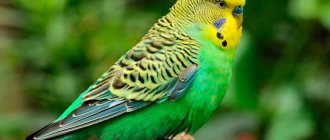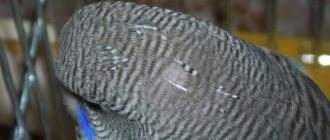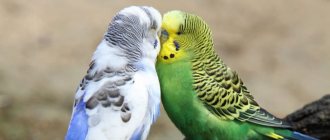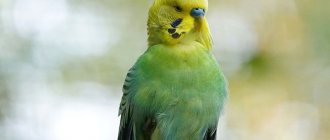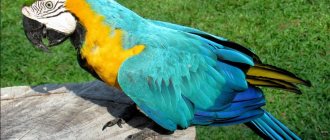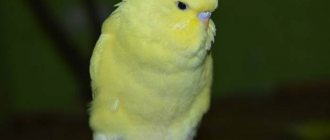To uninitiated people, the singing of budgies may seem like meaningless bird chatter. After all, parrots are not the usual dogs or cats, whose habits have long been studied and understood. However, they are the same living beings, having their own preferences, individual character and even personal opinion. With the help of bird trills and a special behavior characteristic of a particular case, a parrot can tell its owner about its needs, the joy of meeting a person, or, conversely, express dissatisfaction.
After reading the article, you will learn how to decipher bird language and learn to better understand your pet. You will also be able to see with your own eyes all the variety of dances and hear what sounds parrots are capable of making while living side by side with humans.
Singing budgerigars
All the names of budgies are in one way or another connected with the words “noisy”, “singing”. This is explained by their special love to chat, sing, make noise, which is what they do all day long. The approach of the flock can be heard from afar, even before it appears on the horizon.
Interesting! Parrots produce a whole range of sounds from screams and chirps to melodious trills, but most owners do not understand what the bird wants to say with its singing. In fact, everything is extremely simple - you need to watch the parrot, listen with what speed, volume, intonation it sings this or that song or pronounces individual sounds.
In their natural environment, parrots live in pairs. Singing for them is a kind of roll call so that the partner does not get lost in the pack. With the help of chirping, they call their offspring in different tones, pronouncing “chivik.” Each bird has a personal designation akin to a person’s name, so the chicks understand perfectly well that their parents are addressing them and fly to the call.
In the morning, the birds hold something like a meeting about where the flock will go today. Budgerigars scream loudly, scream in every possible way, the noise is several times greater than the warm-up of an instrumental brass band. Then the flock soars up in an instant, the tonality of the budgies' chirping changes to a calm, everyday melody.
When the mating season begins, parrots coo in a particularly quiet, gentle way. Similar behavior is observed both in already formed couples and in single male budgerigars, who try to attract the attention of the females they like with romantic songs. The male sings the same songs to the female who is incubating the eggs.
Reviews
My pets are a male and female budgerigar. They're still talkers. They constantly have conversations with each other. It's a pleasure to watch them communicate. Sometimes I even try to intervene in their conversation, and in response they begin to swear at me. Very funny birds .
I decided that I would gradually study their habits and conversations. They are too businesslike and very similar to us, people. Inna. A budgie was given to me for my birthday. A very beautiful talkative female. I fed her, cleaned her cage, listened to her songs, and that’s it. One day I came across an article that the chirping of wavy animals is a kind of communication with their owners. And I decided to follow my bird. Often my beauty wandered around the cage and flapped her wings on the sides. This interested me and I read what it means. It turned out that she was so indignant and lacked attention . I began to spend time with her more often, talk, play. Our communication has improved and now my beloved pleases me with beautiful songs.
Valeria.
I had a lot of different pets in my house. And I can say with complete confidence that each animal has its own character, just like people. A couple of years ago I had a budgie. By nature he is quite calm and obedient. But, nevertheless, if he was angry and dissatisfied with something, he could bite , while swearing loudly. And yet they are beautiful birds. Their singing is something unimaginable. It’s incredibly nice to come home after work and plunge into this singing. Tamara.
There are six budgies in my house. Equal numbers of females and males. And silence is an extremely rare guest in our house. Birds have interesting conversations with each other around the clock. They discuss something emotionally with gestures, and sometimes it even leads to fights .
Sometimes parrots copy the chirping of birds outside the window. I like to sit down in the evening with a cup of tea, listen and watch their lives, conversations, movements. I'll tell you a very interesting activity. Oksana.
Why do birds dance and sing?
Parrots are known as avid music lovers. Moreover, individuals living together may have completely different musical preferences. What kind of music a particular budgie will like and become a favorite will depend on its temperament and character. So, some prefer the sounds of an instrumental orchestra, while other budgies like songs that have vocal accompaniment. The bird sings along with the performer, imitating intonation, repeating individual words, thereby expanding its vocabulary.
Interesting! Most budgies do not like listening to club music or techno music. The bird becomes aggressive and can scream and flap its wings.
Many owners report that their pets, in addition to singing, love to dance, and this activity completely captivates them for several hours. Parrots really have a sense of rhythm, they move well to the beat of the music: they rhythmically wave their heads and wings, dancing and moving their paws.
It is difficult to reliably explain the fact that parrots are addicted to music, singing and dancing. Scientists have helped bring some clarity by finding nuclei in their brains responsible for learning, which no other bird has. These are isolated groups of neurons that help parrots remember and later reproduce sounds. They are closely adjacent to the motor centers of the brain, which allows the speech center to control the movement of the tongue, and at the same time the rest of the bird’s body. Regarding what kind of music budgerigars like, a close relationship has been discovered between the preferences of the pet and its owner.
Adaptation of a parrot in the house (after purchase)
Adaptation of a bird from the moment it appears in a new home lasts on average 1–3 weeks. The specific meaning depends on the nature of the bird and its other individual characteristics. During this period, the correct behavior of all family members is important. So in the first few days it is better to leave the bird alone and place the cage in a quiet place. This will help calm and adapt your pet faster.
Interesting! If your pet accidentally escapes from its cage, there are many ways to return it without damaging its nervous system. During adaptation, it is important to establish a trusting relationship between the bird and the owner.
Sometimes during this period the following symptoms are observed:
- The pet refuses to eat or throws away the food. Normally, this behavior lasts no more than 6–7 hours from the moment of living in a new home. The birds themselves eat quite a lot, so a longer refusal indicates the presence of health problems. If a parrot throws food out of a bowl or steals it, this is normal behavior during adaptation. This means that hunger takes precedence over fear.
- Loose stools. It can be a symptom of severe stress or the onset of an illness. In the first case, this condition lasts no more than two days.
- Weak activity. The bird's inactivity may be due to fear. The parrot is afraid to attract attention and sits in the corner.
- Lack of sleep. Birds are afraid to stay in a new room. Therefore, the parrot does not sleep at night for the first 24 hours.
- Panic. The pet flaps its wings and flies chaotically around the cage. You can calm him down by dimming the lights in the room. After the parrot has had a good night's sleep, it will feel much better.
Important! The nervous system of these birds is quite sensitive. During the move, the pet experiences severe stress and even pulls out feathers on its body. Therefore, the owner must help go through the adaptation period.
Sounds of budgies
Various sounds in the repertoire of budgies change their meaning when intonation changes. But an attentive owner will easily understand what his pet wants to say with his singing, and a kind of short bird language translator presented below will help him with this.
- If there are any changes in the appearance of the owner or in the room where the bird is located, and the parrot notices them, he will express surprise by repeating the cry “piu”.
- The feathered one, dissatisfied with the innovations, repeats “quaw” sharply and loudly for a long time.
- The incessant cheerful singing of the chivi-chivi bird indicates that it is interested in something unfamiliar to it or is doing something that is forbidden. For example, he damages furniture, wallpaper, or tries to chew through a wire.
- The sounds of “cha-cha” pronounced in a loud, harsh voice mean that the bird is scared. They, said with a calmer intonation, speak of the parrot’s high spirits. If the sound becomes more intense and louder, then the bird wants to be let out of the cage for a walk.
- The bird uses the “pichi” call when it seeks communication with other birds it sees outside the window or sitting nearby in a cage. Calm singing is most likely addressed to a person or other pet.
- A gusty, loud “pitii-pitii” whistle heard from a budgerigar can mean dissatisfaction. At this moment, the parrot quickly walks around the cage, spreading its wings. Translated from his language, this indicates that the bird was disturbed or, conversely, little attention was paid.
- The chirping of “chak-chwa” parrots is nothing more than a joyful greeting to a person or pet.
- If a budgie constantly interrupts its songs with a sharp “pity”, this means that something is bothering or irritating the bird, and it needs to be removed from the cage. It can also mean that the parrot is hungry. He will shout out his demand until the owner stops what he is doing and pays attention to the bird.
- A budgie that is forcibly held in the hands or frightened screams “kweee” heart-rendingly.
- In the evening, sitting in the cage, the parrot will switch to a peaceful, increasingly quiet “kwe”, which, translated from bird language, means that it is time to go to bed.
Why does a parrot make loud noises?
Breeders should be wary of the frequent loud sounds that wavy pets begin to make. Usually noise among birds arises when there is possible danger, or when they feel discomfort. This often happens when the birds have just been acquired and they are getting used to the new room, or when the owner does not pay attention to them. The banal absence of a partner can also cause the bird to become restless and scream. To find out the true cause of the night screaming, you need to analyze the behavior of the birds, and also take into account all possible factors that could lead to this condition.
- The parrot screams and runs around the cage
This happens when the bird has an excess of energy due to lack of physical activity. If the parrot is not allowed to fly much, and there is also a small cage, then naturally the feathered pet will begin to be indignant. But this can also be observed when changing the usual diet, during the mating season, or during stress (for example, loss of a mate).
- Scream at dawn
At dawn, both domestic budgerigars and their wild relatives begin the time for vocal activity. In this situation, screaming is a variant of the norm for birds. They are healthy, cheerful, ready for new adventures. The morning cry of parrots is comparable to the crowing of roosters, and marks the beginning of a new day. Smart birds want to tell people: “Good morning! Climb!".
- Screams at night
Usually budgies are passive at night - they rest and sleep. The loud squeaking of chicks in the middle of the night should alert you. This happens if the birds are feeling unwell, acute pain, or something has caused them severe fright (loud sound, harsh light, the appearance of a cat near the cage).
How to Avoid Noisy Parrot Behavior
Usually, budgies are quiet, and their cute chirping only enlivens the situation. If the birds begin to scream all day long, creating unimaginable noise from morning to night, then you need to deal with possible provoking factors and eliminate them as much as possible:
- Create the most comfortable living conditions.
- Protect birds from possible sources of disturbance.
- Review your pets' diet.
- Analyze the dimensions of the cage and, if possible, organize a more spacious enclosure.
- Let the parrots fly around the apartment.
- When keeping a single pet, spend a lot of time communicating with your pet, or buy him a pair.
- Contact a veterinarian if you suspect an illness.
- Undergo veterinary preventive examinations on time.
Summarizing
A budgie, like any other pet, requires sufficient time and attention from its owner. If the owner is patient and regularly works with his pupil, then soon the training will bear fruit - the bird will speak, repeating not only individual words, but also entire sentences. He will copy intonation, surrounding sounds, and delight family members with dancing and cheerful singing.
An attentive owner who has studied the habits of a feathered pet will be able to find a common language with it. This will make it comfortable for both the bird, whose needs will be understood and satisfied, and the owner, who can quickly determine by the behavior and singing of the budgerigar his emotional state, the cause of anxiety or joy.
Unusual behavior as a signal of illness
Sometimes the bird can open its beak, but there are no sounds. And this is repeated several times in a row. In this way, birds clear their throats of fluff that has gotten into it. Another reason could be stuck food. But you shouldn’t be afraid of this; your pet can easily cope with this problem.
But this behavior is also typical when infected with tracheal mites. In this case, a decrease in appetite, lethargy of the bird and a decrease in activity are added. The parrot does not fly out of the cage and is indifferent to treats and attention from the owner. Such reasons require an urgent visit to a veterinarian.
Important! The symptoms are also dangerous if the bird does not want to leave the cage, only sits and breathes with its beak open. They are characteristic of respiratory diseases and require immediate veterinary attention.
A pet sitting and hiding its head under its wing when it is usually awake also indicates health problems. This behavior may be accompanied by refusal to eat, weakness, apathy and difficulty breathing. Sometimes the parrot itches a lot and plucks its feathers, tumors form on its back and weight loss occurs.
In order to promptly recognize a bird’s poor health or the onset of an illness, the owner must know the body language of these birds. By behavior you can “read” the bird’s mood, its desires and needs, signals of poor health, and much more.
Budgerigar: can he learn to talk in one day?
The budgerigar is a bird that brings joy with its chirping and playful disposition. You definitely won’t get bored with such a pet! Another advantage of the parrot is its ability to talk. Therefore, owners who have purchased a bird certainly want to teach their pet the wisdom of human speech.
In fact, pushing a parrot to communicate with a person is not so easy. In order for a pet to repeat at least one word, months of training are required. Therefore, do not believe posts on the Internet that promise that the bird will speak in one day or even a week. This is simply impossible.
Photo: pixabay.com: UGC
On average, training a parrot will take about 3 months. The deadline can move in one direction or the other depending on the pet's ability.
Important note: if you want to train a parrot, do not do it immediately after purchasing it. Wait a week or two for your pet to get comfortable and get used to you. First, gain the bird’s trust, and only then stimulate him to new knowledge.
Recommended age to start training
Budgerigars become adults by 9–10 months. It has been noticed that young birds cope much more successfully with sound imitation lessons than adults.
Experts believe that the optimal time when a parrot begins to accept training is from 1 to 4 months. While the teenage bird is in the nest, they do not work with it. If a person begins to regularly communicate with a budgie that has been separated from its parents, it will start talking within 3–3.5 months.
Interesting! Even the most experienced trainer cannot quickly teach five-month-old (and older) wavy dogs to talk. This will require several months and a lot of patience from the owner. There will be a result, but only if the parrots have a balanced diet and good care for them.
List of funny words and phrases or what to expect from a feathered friend
A talking budgie is not uncommon; almost anyone can learn to say a few words. It’s interesting when words and phrases are said at the right time and at the right time. For example, Roma, a five-year-old parrot, always says “Hello!” to everyone entering the room, and then asks, “How are you?” and happily reports: “Everything is fine, the children are at school.”
In addition, the vocabulary of pets may include the following phrases:
- I'm old, terribly beautiful.
- Katya, get up, it's time to eat
- Children at the dacha
- It's hot, it's hot, you need to eat
- Would you like some tea? Would you like some coffee?
If you are not careful, and your pet ends up in the company of not very well-mannered people, he will bring curse words into the house, and will pronounce them clearly. And not only the harmless ones - “fool”, “idiot”, “get out”, “damn it”. There are also non-printed ones...
If you liked the article or have something to add, then leave your comments and also join our VKontakte group.
Chatty boys and stupid girls
There is an opinion that it is impossible to teach parrot girls to talk. Actually this is not true. Both girls and boys eventually begin to talk, and the girls pronounce their words more clearly and understandably.
All parrots, regardless of gender, have the same structure of the sound apparatus, the peculiarity of which is the absence of vocal cords.
The sounds that budgies make are formed in the lower larynx, so the bird doesn’t even need to open its beak to talk; it is a natural ventriloquist. In the chest cavity there is a kind of chamber with external vocal membranes. Parrots have four sound sources - modulators, versus the usual two, which helps them successfully imitate human speech.
Males by nature are obliged to attract attention, to show themselves in all possible glory, including conversation. Females are passive, they do not need to win fans - they simply choose the best and do not bother too much about demonstrating skills. Their calling is eggs, and then chicks. Therefore, the female usually begins to speak later than the male, which became the reason for the myth about the lack of intelligence of female parrots.
You can achieve the favor of a budgerigar and reveal the conversational talent of a cute feathered friend with patience and affection. There is no need to wonder in vain: do female budgerigars talk? You need to love and train them regardless of gender, and sometimes even age.
Tips and tricks
When parrots say words or combinations of words, this does not mean that they understand the meaning of what was said. Birds simply imitate a sequence of sounds.
Experts advise that after the first 10–12 lessons you associate the pronunciation of a task word with a specific situation. It is better to choose actions that are repeated day after day. For example, a greeting at a meeting, an invitation to a meal or a swim (“eat”, “swim”, “hello, Kesha”).
Experienced breeders confirm that the main success factors are:
- patience;
- competent approach;
- motivation;
- lack of stress;
- regularity of training.
To consolidate the achieved results, a mirror removed from the cage during training helps a lot. The parrot, who is satisfied with the communication with the owner, immediately begins to “tell” the attribute placed in its usual place about its successes and repeat the memorized sounds.
Birds mistake their reflection for a cute relative, and are happy to share the news with him.
Can an adult bird begin to pronounce words?
The lifespan of a budgerigar is about 10-12 years in captivity. Naturally, a bird can live that long if it is properly maintained. It should be noted that, according to ornithologists, birds can live approximately the same amount of time in the wild.
Budgerigars mature quite early. At one year of age, puberty begins, when the female can lay eggs. At the same time, laying eggs is possible only if there is a place for nesting, so breeding budgerigars in captivity, as a rule, does not present significant difficulties.
At the same time, young parrots actively learn new things and have good learning abilities for up to 6 months. Of course, this does not mean that older pets are not able to imitate the sounds of human speech. However, it should be understood that training adult birds may require a significantly greater commitment on the part of the owner, both in terms of time and effort expended.
Adult females with already hatched chicks are least amenable to learning to speak.
In general, it is much more difficult to teach an adult bird to speak, and therefore young birds are recommended for purchase.
Fast way to learn
Teaching birds to sound imitate human speech is a slow and painstaking process. At least 2.5–3 months will pass before the owner of the wavy notices that the pet is talking.
To speed up the results, you should pay attention to the following points:
- During the lesson, the bird should be slightly hungry. This stimulates her activity.
- You should not delay classes so as not to discourage the parrot from wanting to communicate.
- You need to start learning with short words.
- Constantly monitor your pronunciation.
- Do not show aggression towards your pet, even if something doesn’t work out for him.
It has been noticed that budgies learn to speak faster if the owner uses the technique of twice-daily training. Such classes are conducted with a significant period of time between them and last no more than 10–12 minutes. For example, you could have your first lesson at around 9am and your second at around 5pm.
Does the ability to speak depend on gender?
All breeders agree that it is much more difficult to teach wavy girls to talk than males.
The owner, who has spent a lot of effort teaching the female to speak, is rewarded with clear pronunciation of words and entire phrases. This is considered a big victory. There are cases when a female taught the correct pronunciation of the words of a male placed next to her.
Conversely, a well-trained boy usually begins to share his skills with a young girlfriend assigned to him.
Interesting! It is much easier to teach a bird to talk if the parrot is alone in a cage. A pair of wavy cats that live together are always busy with each other and it is useless to teach them sound imitation at home.



